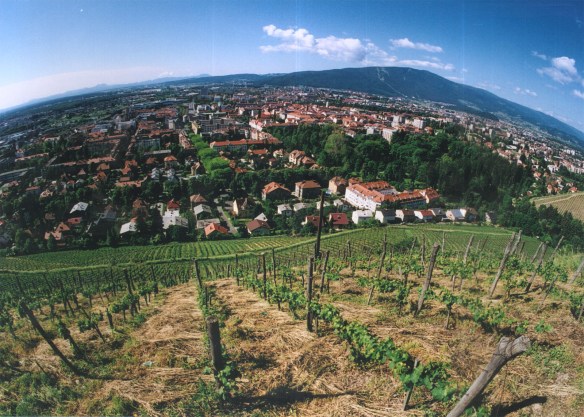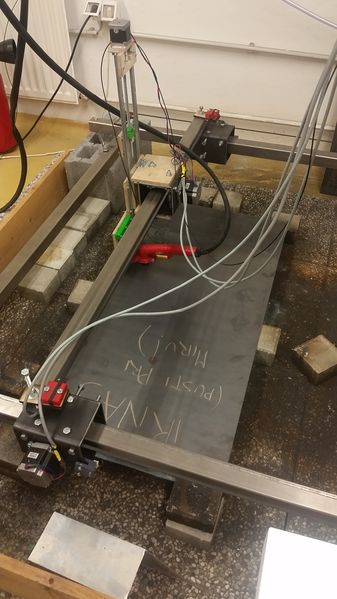This summer marked the 8th annual Battle of the Mesh in beautiful Maribor, Slovenia at the foot of the Swiss alps. Each year, folks from around the world who work on open source mesh networking protocols (schemes for routing packets across a network) and community wireless networks converge to deploy a testbed mesh network, running different protocols on top of it and analyzing which of them perform the best.

Mount Pohorje in Maribor, Slovenia, site of BattleMesh v8!
This year, the conference agenda also included a wider variety of topics, from decentralized and secure file systems and applications to political discussions about the future of open hardware and firmware in the face of imminent federal regulatory lockdown measures.
The first day was largely spent socializing and setting up the topology of the network:
Topology of the testbed network built at BattleMesh v8
Five actively maintained and deployed routing protocols were tested over the course of the week:
* Babel, a distance-vector routing protocol for IPv6 and IPv4 largely developed by Juliusz Chroboczek in France;
* Batman-adv, an implementation of BATMAN [Better Approach to Mobile Ad-hoc Networking], spearheaded by the Germany-based Freifunk community;
* BMX7, an experimental protocol designed to bridge Layer 2 and Layer 3 routing;
* OLSRd1, short for ‘Optimized Link State Routing’ and widely utilized in many of community networks due to its stability, scalability and active development community,
* OLSRd2, a new iteration of OLSR designed to be more modular and flexible, published by the IETF in 2014.
Day 2 started out rather chaotically, as a dozen wireless hackers attempted to fix the internet they’d borked. The afternoon’s talks featured an excellent presentation by Julius, the lead developer of Babel, entitled ‘babel does not care.’ You can watch the talk (with accompanying slides) here. Julius’ talk was followed by a presentation of GNUnet, a free-as-in-freedom alternative and privacy-conscious network for peer-to-peer filesharing, VOIP communication, and peer discovery that works over a variety of transport mechanisms. Watch the full talk with slides here. Next, Elektra of Freifunk gave a presentation on the current state of TV whitespace spectrum and the potential future applications of UHF. I highly recommend watching the talk, as Elektra concludes with a stirring call-to-action for the community to engage with the political struggle over spectrum allocation, one unfairly slanted toward powerful telecommunications companies over free and open community network usages.
Day 3 kicked off with a presentation by Mathieu Boutier on source-specific routing in Babel [Video]. Next came a presentation on cjdns, a distributed and end-to-end encrypted p2p IPv6 meshnet project better known as Hyperboria. They have just begun collaborating with a fascinating project called IPFS, the Interplanetary File System, which combines ideas from Git, Bittorrent, and the web to enable such applications as peer-to-peer filesharing through creating a distributed content cache accessed through a hashed URL. Check out their talk, which appropriately followed the cjdns presentation. Folks from Battlemesh are using IPFS to store media content uploaded by conference participants!

An easy-to-assemble, open hardware plasma cutter from Irnas.
We celebrated the mid-point of the conference by spending the afternoon and evening in Maribor, first with a tour of KreatorLab. KreatorLab is home to a bevy of inspiring open hardware projects, including a plasma cutter, a 3D printer, and Koruza, Musti’s brainchild enabling gigabit wireless optical links.
After our visit to KreatorLab, we headed over to the GT22, a self-described “transdisciplinary laboratory in real space with transnational guerilla art school institutes” hosting space for theater rehearsals, a radical library, a photography museum, an indoor skating ramp and a party space populated by a VJ projection screen and a DJ booth. While the DJ played dance music, our true-to-form hackers proceeded to gather outside and along the walls not dancing 🙂
Thursday, Day 4 of the conference, began with a presentation of Cake (Comprehensive Queue Management Made Easy), a project that works to make wifi faster by reducing network latency. The following presentation by Dave Taht provided an excellent overview of the current insecurities in Internet of Things devices outlined across 11 layers of the network stack, culminating in a rousing call-to-action for hackers to build more and better open hardware. I highly recommend watching this talk!
Dave’s talk was a fitting antecedent to the subsequent presentation and discussion of the FCC’s recent proposal to lock down wireless routers by requiring vendors to “ensure that only properly authenticated software is loaded and operating the device.” This has huge implications for community networks in the US, with similar rules being discussed for the EU and Canada. After a heavily animated discussion, folks continued to discuss the issue over lunch, with many inspired by Dave’s talk to create our own hacker-friendly hardware down to the chipset level. We created a mailing list to collaboratively compose letters to the FCC, the comment period for which has recently been extended to October 9th and is open to everyone.
Unfortunately, I missed the entirety of Thursday afternoon’s talks as I literally sat in the same spot at our lunch table conversing with new friends into the evening.
Friday kicked off with a presentation from Demos to consolidate and test various decentralized applications with the aim of supporting a more decentralized web. She was followed by Nemesis presenting, NetJSON and Nodeshot, projects working to build node databases for network monitoring and administration. After lunch, Paige gave an impressive presentation on MaidSafe, a secure and decentralized storage and communications platform.
On the last day, a few of us set up a video camera and did short interviews with representatives from as many community wireless networks as we could gather. The focus of the interviews was to explore the various motivations and unique challenges faced by a diversity of community networks, with the aim to inspire and guide the development of many more to come. Watch this blog for updates once the videos have been edited and posted to the web!
So… which protocol won?
Given the complexity and variety of tests and analytics, the ‘winner’ is difficult to determine. Check out the beautiful (and nearly complete!) documentation, including detailed graphs and links to git repos of the software used to test the network here.
Please drop me a line at jenny [at] sudomesh [dot] org if you’d like to help plan for the very first ‘BattleMesh West’ at the Omni Commons next year!
Leave a Reply